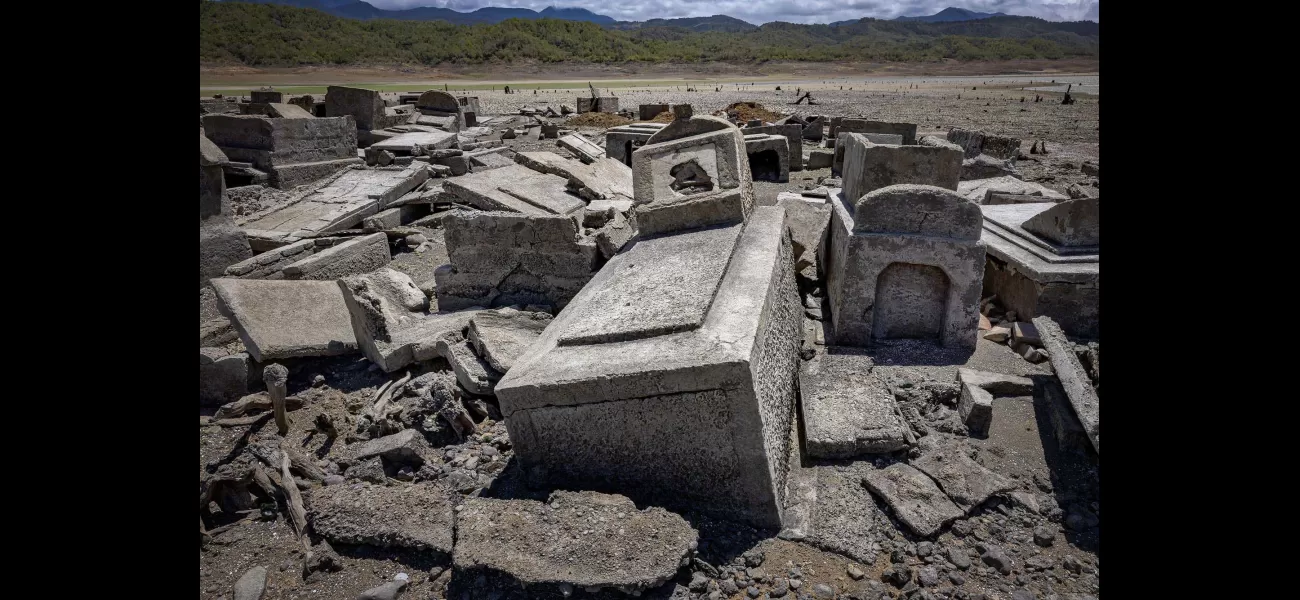A 300-year-old village resurfaces from a dried-up reservoir during a period of drought.
A submerged settlement from the 1700s in the Philippines has resurfaced due to extreme heat and drought draining the dam.
April 30th 2024.

In the Philippines, a settlement that was once submerged under a dam has resurfaced after nearly 300 years. The sweltering heat and drought that have been plaguing the country have caused the reservoir to dry up, revealing structures like a church, tombstones, and a municipal hall marker. Marlon Paladin, a supervising engineer for the National Irrigation Administration, explained that this phenomenon occurred in March when there was hardly any rain.
Interestingly, this area was intentionally flooded back in the 1970s during the construction of the dam. However, the current drought has led to a significant decrease in water levels, as reported by the Philippine government's weather agency, PAGASA. In fact, the water levels on April 30 were almost 50 meters lower than usual. This has caused the submerged settlement to emerge for the sixth time since the reservoir was created, but this time, it has been visible for the longest period according to Paladin.
When the ruins resurface, they become a popular tourist attraction. As with many countries in Southeast Asia, the Philippines has been experiencing scorching heat for the past few weeks. The temperatures have been so extreme that schools have had to suspend classes, with some areas reaching a high of 42 degrees Celsius. Although April and May are typically the hottest months in the country, this year has seen even higher temperatures, with some areas recording a heat index of over 40 degrees.
Speaking of the heat index, it is a calculation of what the human body perceives the temperature to be. It takes into account factors like humidity, which can affect the body's ability to cool itself. In the town of Muñoz, located near the dam, the heat index has risen to over 41 degrees in the past five days. On Sunday, it even felt like 47 degrees due to other contributing factors.
As of the end of March, most of northern and central Luzon, including Nueva Ecija province, where the dam is located, is experiencing a drought, according to PAGASA. And this dry spell has continued into April, with central and southern Luzon receiving less than 25% of the expected rainfall. This year, the El Niño climate pattern has worsened these conditions, which is a natural occurrence on top of the planetary warming caused by human-driven climate change.
In recent years, the temperatures in this region, which is one of the most vulnerable areas to climate change, have reached unprecedented levels. According to climatologist Maximiliano Herrera, hundreds of millions of people have been suffering in the unforgiving heat and humidity. In fact, last spring, there was a record-breaking heatwave in several Southeast Asian countries, with temperatures exceeding 37 degrees. A report from the World Weather Attribution in 2023 described this heatwave as a once-in-200-years event that would have been almost impossible without the influence of climate change.
Interestingly, this area was intentionally flooded back in the 1970s during the construction of the dam. However, the current drought has led to a significant decrease in water levels, as reported by the Philippine government's weather agency, PAGASA. In fact, the water levels on April 30 were almost 50 meters lower than usual. This has caused the submerged settlement to emerge for the sixth time since the reservoir was created, but this time, it has been visible for the longest period according to Paladin.
When the ruins resurface, they become a popular tourist attraction. As with many countries in Southeast Asia, the Philippines has been experiencing scorching heat for the past few weeks. The temperatures have been so extreme that schools have had to suspend classes, with some areas reaching a high of 42 degrees Celsius. Although April and May are typically the hottest months in the country, this year has seen even higher temperatures, with some areas recording a heat index of over 40 degrees.
Speaking of the heat index, it is a calculation of what the human body perceives the temperature to be. It takes into account factors like humidity, which can affect the body's ability to cool itself. In the town of Muñoz, located near the dam, the heat index has risen to over 41 degrees in the past five days. On Sunday, it even felt like 47 degrees due to other contributing factors.
As of the end of March, most of northern and central Luzon, including Nueva Ecija province, where the dam is located, is experiencing a drought, according to PAGASA. And this dry spell has continued into April, with central and southern Luzon receiving less than 25% of the expected rainfall. This year, the El Niño climate pattern has worsened these conditions, which is a natural occurrence on top of the planetary warming caused by human-driven climate change.
In recent years, the temperatures in this region, which is one of the most vulnerable areas to climate change, have reached unprecedented levels. According to climatologist Maximiliano Herrera, hundreds of millions of people have been suffering in the unforgiving heat and humidity. In fact, last spring, there was a record-breaking heatwave in several Southeast Asian countries, with temperatures exceeding 37 degrees. A report from the World Weather Attribution in 2023 described this heatwave as a once-in-200-years event that would have been almost impossible without the influence of climate change.
[This article has been trending online recently and has been generated with AI. Your feed is customized.]
[Generative AI is experimental.]
0
0
Submit Comment





